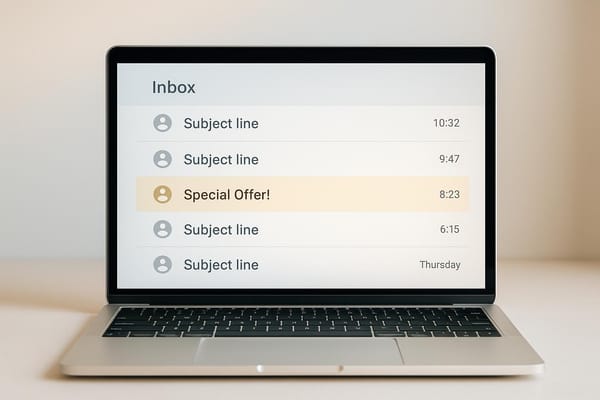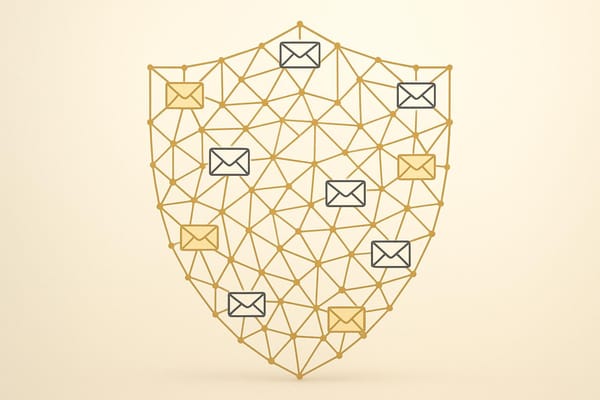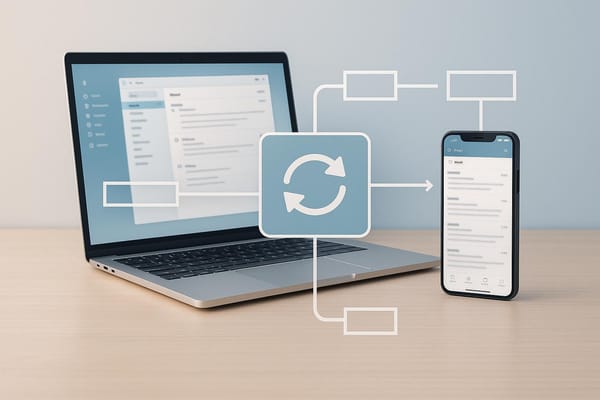Cold Email Compliance Checklist 2025
Ensure your cold email campaigns comply with regulations like CAN-SPAM, GDPR, and CCPA while maximizing deliverability and trust.
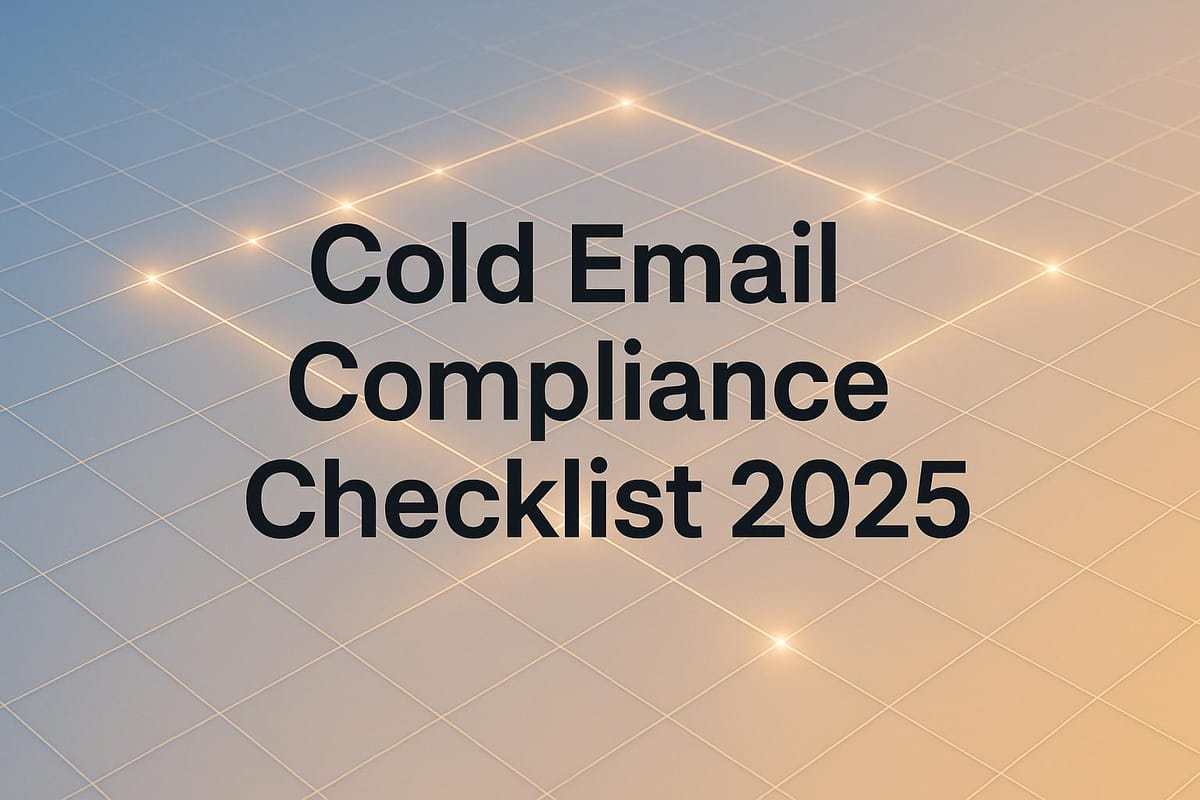
Sending cold emails in 2025? Compliance is non-negotiable. With fines reaching $53,088 per email under CAN-SPAM and €20 million under GDPR, ignoring email regulations isn’t worth the risk. Here’s what you need to know:
- Key Regulations: Follow CAN-SPAM (US), GDPR (EU), and CCPA/CPRA (California) rules. Each has specific requirements for transparency, consent, and opt-out mechanisms.
- Technical Setup: Use SPF, DKIM, and DMARC to authenticate emails and avoid spam filters. Automation tools like Icemail.ai can simplify this process.
- Content Rules: Write clear subject lines, identify yourself, include a privacy policy link, and provide an easy unsubscribe option.
- List Management: Verify email lists, document consent, and clean up inactive or bounced addresses regularly.
- Penalties: Non-compliance can lead to severe fines and damage your sender reputation, pushing emails into spam folders.
Pro Tip: Platforms like Icemail.ai streamline compliance by automating technical setups and managing email infrastructure. Focus on personalized, targeted outreach to see reply rates between 8% and 20%.
Stay compliant, protect your reputation, and improve deliverability by following these steps.
How to Legally Send Mass Cold Emails in 2025 (Complete Guide)
Key Cold Email Regulations You Need to Know
Cold emailing comes with its own set of legal requirements, and compliance is non-negotiable. Three major regulations you need to consider are CAN-SPAM (US), GDPR (EU), and CCPA/CPRA (CA). If your campaigns cross borders, you’ll need to align with multiple rules at once. Here’s a breakdown of what each regulation entails and the penalties for non-compliance.
CAN-SPAM (United States)
The CAN-SPAM Act lays out clear rules for commercial emails sent within or to the United States. Its focus is on transparency and giving recipients control over their inboxes.
Here’s what you need to know:
- Your "From" field must accurately reflect who is sending the email.
- Subject lines must be honest and directly related to your email content.
- A valid physical postal address must appear in the footer.
- You must include an easy-to-use unsubscribe option that actually works.
While prior consent isn’t required for the initial email, you must meet all technical requirements. If someone opts out, their request must be processed within 10 business days. Violations can cost you up to $53,088 per email, and the Federal Trade Commission actively enforces these rules.
Next, let’s look at GDPR, which has stricter data protection rules.
GDPR (European Union)
The General Data Protection Regulation (GDPR) focuses on protecting personal data and respecting individuals' rights. When it comes to cold emails, you’ll need a lawful reason to contact someone - this could be explicit consent (ideal for B2C) or legitimate interest (common for B2B).
Transparency is key:
- Clearly identify yourself and explain why you’re reaching out.
- Let recipients know how you obtained their information.
- Include a link to your privacy policy.
- Make it easy for recipients to unsubscribe or request data deletion.
Under GDPR, individuals have the "right to be forgotten," meaning they can ask you to delete all their personal data from your systems. You’re required to fulfill these requests within 30 days. Non-compliance can lead to fines as high as €20 million or 4% of your global annual revenue, whichever is greater.
Now, let’s explore California’s stringent privacy laws.
CCPA/CPRA (California)
California’s privacy laws, CCPA and its amendment CPRA, set strict guidelines for businesses contacting California residents.
Here’s what’s required:
- You must disclose how you collect and use personal data before or at the time of contact.
- California residents have the right to:
- Know what personal data you collect.
- Delete their personal data.
- Opt out of the sale or sharing of their data.
These laws apply to businesses that meet one or more of the following criteria:
- Annual revenue exceeds $25 million.
- You handle personal data from 100,000 or more consumers.
- 50% or more of your revenue comes from selling personal data.
Penalties for violations range from $2,500 to $7,500 per incident.
| Regulation | Key Requirements | Maximum Penalty |
|---|---|---|
| CAN-SPAM (US) | Accurate sender info, truthful subject, physical address, easy opt-out | $53,088 per email |
| GDPR (EU) | Lawful basis, consent/legitimate interest, privacy policy, right to be forgotten | €20M or 4% of global turnover |
| CCPA/CPRA (CA) | Data use disclosure, opt-out mechanism, consumer rights (know, delete, opt-out) | $2,500–$7,500 per violation |
Staying compliant isn’t just about avoiding hefty fines - it’s also about fostering trust and maintaining a professional reputation. While these rules may seem overwhelming, many email platforms can automate compliance features, leaving you free to focus on creating impactful, lawful campaigns.
Pre-Send Compliance Checklist
Before hitting "send" on your email campaign, it’s essential to complete a few key compliance steps. These checks not only help you avoid costly fines but also improve the chances of your emails landing in your recipients' inboxes.
Verify List Sources and Consent
Your email list is the backbone of compliance, so it’s critical to document the source of every contact. For B2B outreach, GDPR allows you to rely on "legitimate interest" - as long as you clearly explain how you obtained the contact, such as, "We found your contact information on LinkedIn." Keep detailed records of these sourcing methods, as they’re essential for audits or compliance reviews.
For B2C contacts, GDPR requires explicit consent. Make sure you have clear opt-in records before sending any promotional emails. Additionally, under the CAN-SPAM Act, maintain an updated suppression list to ensure you’re not emailing anyone who has previously opted out.
Set Up Proper Technical Authentication
Technical authentication plays a dual role - it ensures compliance and boosts deliverability. To protect your emails and verify their authenticity, set up SPF, DKIM, and DMARC records for your sending domain. Here’s how they work:
- SPF: Specifies which mail servers are authorized to send emails on your behalf.
- DKIM: Adds a digital signature to your emails, ensuring message integrity.
- DMARC: Defines policies for handling unauthenticated emails and provides feedback on potential issues.
Since manual setup can be error-prone, consider using automated tools to simplify the process. Proper authentication not only secures your emails but also aligns with global compliance standards.
Use a Professional Sender Identity
Your sender identity is a key factor in building trust and meeting compliance requirements. Always use a professional, monitored email address tied to your business domain (e.g., jane.doe@yourcompany.com). Clearly display the sender’s name and company in each email, and make sure the "Reply-To" address is functional and monitored. This not only boosts your credibility but also ensures compliance with CAN-SPAM regulations.
Include a Privacy Policy and Business Address
Transparency is a cornerstone of GDPR and CCPA/CPRA compliance. Include a link to your privacy policy in your emails so recipients understand how their data is used. Additionally, display a valid business address in the email footer. Make it easy for recipients to opt out or exercise their data rights by providing clear instructions and links.
With these steps, you’ll not only meet legal requirements but also establish trust with your audience.
Use Icemail.ai for Fast Inbox Setup
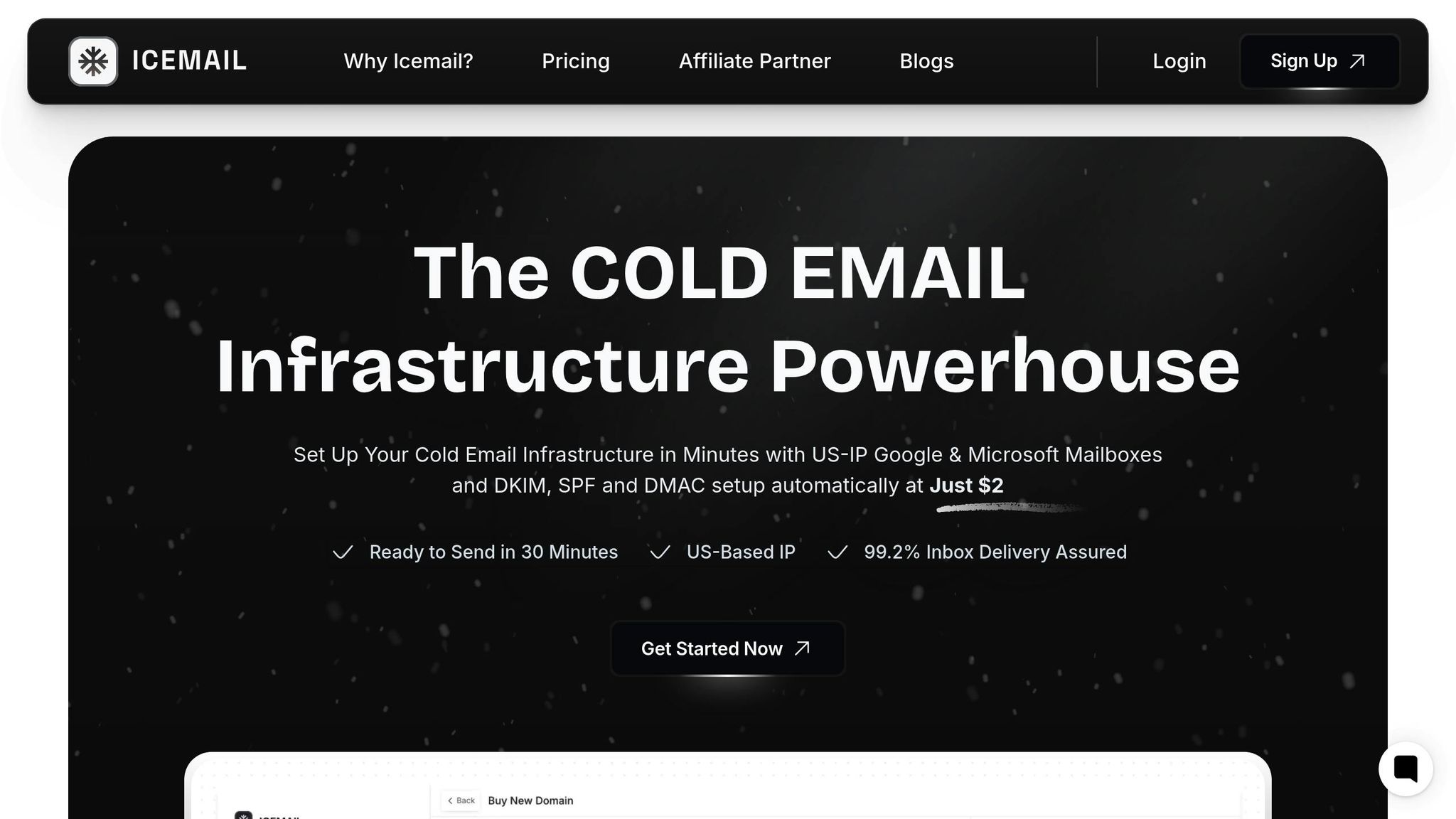
To simplify these compliance and technical steps, Icemail.ai offers an automated solution. The platform handles email infrastructure setup, bulk mailbox purchases, and compliance-ready domain configurations. Features like 1-click import/export and automated SPF, DKIM, and DMARC setup eliminate manual errors and save time.
Icemail.ai supports both Google Workspace and Microsoft mailboxes and offers tools like instant domain setup, bulk updates, and an AI-powered domain finder. With its fast onboarding process, you can have a fully compliant email infrastructure ready the same day you sign up. Compared to competitors, Icemail.ai provides faster setup times and greater reliability, ensuring your emails are both compliant and deliverable.
In-Email Compliance Best Practices
Once your technical setup is ready, it’s time to focus on creating email content that’s not only engaging but also compliant with regulations. The way you craft your emails plays a huge role in meeting legal standards and improving deliverability rates. Getting this right isn’t just about avoiding steep penalties - like $53,088 per email under CAN-SPAM or €20 million under GDPR - it’s also about earning your recipients’ trust. Here’s how to ensure your email content checks all the compliance boxes.
Truthful and Clear Subject Lines
Your subject line is the first thing recipients see, and regulatory guidelines demand honesty. It must accurately represent the email’s content and avoid any misleading claims, as required by both CAN-SPAM and GDPR. For instance, a subject like "Schedule a Demo of [Product Name]" clearly communicates the purpose of the email.
To stay compliant, steer clear of tactics like using "RE:" when there’s no prior conversation, creating false urgency, or advertising “free” offers that aren’t genuinely free. Deceptive subject lines are a violation of CAN-SPAM, and GDPR emphasizes transparency to ensure recipients fully understand the nature of your message.
Clear Sender Identification
Being upfront about who you are and why you’re reaching out is a cornerstone of compliance. Your email must clearly state the sender’s identity, including the company name, a valid physical address, and the reason for contacting the recipient. This information should be easy to spot, not hidden in fine print.
For example, you might write:
"I'm Jane Smith from ABC Solutions. I’m reaching out because I believe our workflow automation tool could help streamline your team’s operations. I found your contact information on LinkedIn and thought this would be relevant to your role as Operations Manager."
Working Unsubscribe Mechanisms
Once your sender details are clear, make sure recipients can easily opt out. A functional unsubscribe mechanism is non-negotiable. Include a one-click unsubscribe link in a prominent spot, typically in the footer. The process should be straightforward - no email confirmations, logins, or forms required. Additionally, maintain a suppression list to ensure anyone who opts out doesn’t receive future communications, and keep records of all opt-out requests for audits.
Personalized and Role-Specific Content
Personalization isn’t just about boosting response rates - it also aligns with compliance requirements. Tailoring emails to the recipient’s name, role, and business context supports the "legitimate interest" clause under GDPR for B2B communications.
Show you’ve done your homework by referencing specific details about the recipient’s company or industry. For example:
"I noticed your company recently expanded to three new markets. Our tracking system helped another logistics company reduce onboarding time by 40%."
This approach demonstrates that your outreach is thoughtful and targeted, not generic spam. In fact, well-crafted cold email campaigns in 2025 can achieve reply rates of 8% to 20%, proving that quality beats quantity every time.
| Compliance Element | Best Practice | Regulatory Requirement |
|---|---|---|
| Subject Line | Must reflect the email’s content accurately | Required by CAN-SPAM and GDPR |
| Sender ID | Include full name, company, and physical address | Required by CAN-SPAM, GDPR, and CCPA |
| Unsubscribe | Provide a one-click link in a visible location | Process opt-outs within 10 days (CAN-SPAM) or 30 days (GDPR) |
| Personalization | Use recipient’s name, role, and company details | Aligns with GDPR’s legitimate interest for B2B outreach |
Don’t forget to include a link to your privacy policy and explain how you obtained the recipient’s contact information. This level of transparency not only meets GDPR and CCPA requirements but also builds trust with your audience. By combining compliance with personalized, relevant content, you’ll not only meet legal standards but also see better engagement rates in your email campaigns.
Ongoing Compliance and Deliverability Management
Taking the right steps before sending emails and ensuring compliance within the email itself is just the beginning. To maintain strong deliverability and stay aligned with regulations, ongoing management is essential. Ignoring compliance can lead to hefty fines and a tarnished sender reputation. On the flip side, consistent management ensures your emails land in inboxes, supporting reply rates of 8% to 20% for well-optimized cold email campaigns in 2025. Here’s how to keep things on track.
Honor Unsubscribe Requests and Manage Suppression Lists
Handling unsubscribe requests promptly is more than just a courtesy - it’s a legal requirement. Under the CAN-SPAM Act, you must process these requests within 10 business days. GDPR is even stricter, requiring action without unnecessary delay and no later than 30 days. Automation is key here; relying on manual processes increases the risk of delays and mistakes.
Your email platform should automatically add unsubscribed contacts to a centralized suppression list that syncs across all systems. This ensures people who opt out won’t be accidentally contacted again, whether it’s through sales, marketing, or customer service campaigns. Regularly auditing your suppression list is also critical to confirm all systems are properly aligned. Keep clear, timestamped records of all compliance activities to demonstrate accountability.
Keep Email Lists Clean
Clean email lists are vital for maintaining deliverability and a strong sender reputation. Invalid addresses, inactive accounts, and repeated bounces can harm your reputation and lead to poor inbox placement. The general recommendation is to clean your lists at least every quarter, but if you’re sending emails at a high volume, monthly cleaning might be necessary.
Start by removing addresses that repeatedly bounce or show no engagement over six months. Email verification tools can help catch typos and invalid domains before they cause issues. Neglecting list hygiene increases the risk of bounces and spam complaints, both of which can hurt your email performance.
Monitor Deliverability and Sender Reputation
Your sender reputation plays a major role in ensuring your emails don’t get caught in spam filters. To keep it healthy, monitor key metrics like open rates, click-through rates, bounce rates, spam complaints, and inbox placement rates. A sudden drop in open rates or an increase in bounces can signal deliverability problems that need immediate attention.
Tools such as Google Postmaster and Microsoft SNDS offer insights into how major email providers view your reputation. Platforms like Icemail.ai can automate the setup of email authentication protocols like DKIM, SPF, and DMARC, while also monitoring deliverability to help maintain high inbox placement rates. It’s also smart to set up alerts for unusual activity, such as spikes in bounce rates or spam complaints, so you can address issues before they escalate.
Document Compliance Efforts
Thorough documentation is your safety net during audits or regulatory reviews. Keep detailed records of how each contact was added to your list, timestamps for consent (if applicable), and every unsubscribe request processed. This not only demonstrates your commitment to compliance but also protects your business if regulators come knocking.
For every email address, document the source, consent evidence, and timestamp. In B2B cold outreach, record your legitimate business interest and how the contact fits your target audience. Automated tools can simplify this process by creating audit trails for you. Store these records securely and make sure they’re accessible if needed. Regular training for your team is also crucial to ensure everyone understands their role in staying compliant.
Optimizing Email Infrastructure for Compliance
Your email infrastructure is the backbone of both compliance and deliverability. Even if your content checks all the compliance boxes, poorly configured infrastructure can still send your emails straight to spam. A solid setup not only protects your sender reputation but also ensures your messages reach the right inboxes. One critical step? Securing your DNS records to strengthen your infrastructure.
Secure Domain and DNS Configuration
Once you've tackled technical authentication, securing your DNS configuration is a must for staying compliant. This means setting up SPF, DKIM, and DMARC protocols. These tools authenticate your emails, safeguard your domain, and ensure compliance with industry standards.
- SPF (Sender Policy Framework): Defines which mail servers are authorized to send emails on behalf of your domain.
- DKIM (DomainKeys Identified Mail): Adds a digital signature to your emails, confirming both the sender's identity and the message's integrity.
- DMARC (Domain-based Message Authentication, Reporting & Conformance): Builds on SPF and DKIM by instructing receiving servers on how to handle unauthenticated emails. It also provides detailed reports to help you monitor potential domain abuse.
Setting up these records can be tricky - it requires technical know-how and precision. Even a small syntax error can disrupt email delivery. Many businesses struggle with these configurations, leading to mistakes that harm both compliance and deliverability.
Provider Comparison
The email infrastructure provider you choose can make or break your compliance and scalability efforts. Key factors to consider include setup speed, automation features, user feedback, and integration options.
| Provider | Setup Speed | Automated SPF/DKIM/DMARC | Bulk Mailbox Purchase | User Reviews | Google/Microsoft Integration | Compliance Tools |
|---|---|---|---|---|---|---|
| Icemail.ai | Fast (30 min) | Yes | Yes | Excellent | Yes | Advanced |
| Competitor A | Moderate | Partial | No | Good | Yes | Basic |
| Competitor B | Slow | No | No | Mixed | Limited | Limited |
Icemail.ai shines with its 10-minute onboarding and an infrastructure that's ready to send emails in just 30 minutes. It automates DNS setup, including SPF, DKIM, and DMARC, removing the technical headaches that often cause compliance issues.
"Icemail.ai has transformed how I manage my email infrastructure. The automated setup for Google Workspace accounts, including DKIM, SPF, and DMARC configuration, saved me hours of work." - Suprava Sabat, @AcquisitionX
The platform’s bulk mailbox purchasing feature, powered by AI autofill, simplifies scaling. You can set up hundreds of mailboxes in three easy steps, with prices starting at $2.50/month for Google Admin mailboxes and $3/month for Microsoft mailboxes. Plus, the pay-as-you-use model offers flexibility without long-term commitments, and it includes full access to mailbox exports.
Scalable and Compliant Sending Strategies
Once your domain is secured and you've chosen the right provider, it's time to focus on sending practices that build trust and reputation. Scaling your email operations effectively means starting small and gradually increasing your sending volume. For new domains, this often means sending 50-100 emails per day initially. This slow ramp-up helps establish trust with email providers while giving you time to monitor key metrics like deliverability.
Gradual volume increases are essential to avoid spam filters. New domains lack a sending history, making them more vulnerable to being flagged. By slowly increasing your email volume over several weeks, you can build a strong sender reputation while addressing any issues early on.
Domain warming is another critical step. Begin by sending emails to your most engaged recipients - those likely to open and respond. This positive interaction signals to email providers that your messages are welcome, which improves your reputation. Avoid sending large volumes from brand-new domains, as this behavior often triggers spam filters.
As you scale, monitoring and adjustments are key. Keep an eye on bounce rates, spam complaints, and open rates during the ramp-up period. A sudden spike in bounces or complaints could indicate you're scaling too fast or facing deliverability problems. Well-optimized campaigns in 2025 have achieved reply rates between 8% and 20%, but only with a solid infrastructure and careful scaling.
Infrastructure redundancy is another strategy to consider. Using multiple domains and mailboxes spreads out your sending volume, reducing the risk of a single domain affecting your overall deliverability. Platforms like Icemail.ai make this easier by automating DNS setup across multiple domains, ensuring compliance as you grow.
In 2025, the focus has shifted toward personalized and targeted emails rather than mass blasts. A well-configured infrastructure becomes more effective over time, supporting steady growth while keeping you compliant with regulations.
Conclusion and Final Checklist
Key Takeaways
Cold email compliance isn't just about following the rules - it's about protecting your campaigns, earning trust, and boosting your outreach results. Ignoring compliance can be incredibly costly, with penalties climbing to thousands of dollars per email in the U.S. and millions under GDPR regulations. On the flip side, companies that stick to compliance best practices often enjoy reply rates between 8% and 20%, while those that cut corners frequently see their efforts relegated to spam folders.
The trend toward prioritizing quality over sheer volume has made compliance more critical than ever. Your technical setup is the backbone of both compliance and email deliverability. Without it, even the most compelling emails won’t reach their intended recipients.
For businesses serious about compliance and efficiency, Icemail.ai stands out as a top-tier solution. With a quick 10-minute onboarding process and infrastructure ready in just 30 minutes, it removes the technical barriers that often complicate compliance efforts. Use the checklist below to ensure your campaigns are fully aligned with regulatory standards.
Final Compliance Checklist
Here’s a practical checklist to help you meet all regulatory requirements for your cold email campaigns:
Before Sending:
- Confirm your email list sources and document consent for every recipient.
- Set up technical authentication for your domains (SPF, DKIM, DMARC).
- Use a professional sender identity, including a real name and business email address.
- Include your physical business address formatted for U.S. standards.
- Link to your privacy policy and provide clear business identification.
Email Content Guidelines:
- Craft truthful subject lines that reflect the email's content.
- Clearly identify yourself as the sender within the opening lines.
- Include a working unsubscribe link that processes requests within 10 business days.
- Personalize your emails based on the recipient’s role or company.
- State a legitimate business reason for contacting B2B recipients.
Ongoing Maintenance:
- Immediately honor unsubscribe requests and maintain suppression lists.
- Regularly clean your email list to remove bounced or inactive addresses.
- Monitor key deliverability metrics like open rates, bounce rates, and spam complaints.
- Keep a record of all compliance efforts for potential audits.
- Review and update your policies every quarter to align with current regulations.
Technical Infrastructure:
- Ensure your domain is configured securely with proper DNS records.
- Use U.S. or EU-based IP addresses to meet regional compliance requirements.
- Gradually scale email volume, starting with 50–100 emails per day for new domains.
- Maintain a strong sender reputation by sticking to compliant practices.
This checklist outlines the key steps for staying compliant with CAN-SPAM, GDPR, and CCPA/CPRA regulations. Regularly auditing your processes with this framework can help you steer clear of penalties while fostering trust and improving deliverability - both critical for cold email success in 2025.
FAQs
How do CAN-SPAM, GDPR, and CCPA/CPRA differ when it comes to cold emailing?
The CAN-SPAM Act, GDPR, and CCPA/CPRA each play a significant role in shaping email practices, but their focus and requirements vary.
CAN-SPAM, which governs commercial emails in the United States, emphasizes transparency. It requires clear sender identification, a valid physical address, and an easy-to-use opt-out mechanism. In contrast, the GDPR, a regulation from the European Union, prioritizes data protection and consent. Under GDPR, businesses must obtain explicit permission before emailing individuals within the EU. Meanwhile, CCPA/CPRA, specific to California, grants consumers control over their personal data. While it requires businesses to disclose their data collection practices, it does not demand prior consent for emails, as GDPR does.
For businesses using cold email outreach, staying compliant with these laws is essential to avoid hefty penalties. Tools like Icemail.ai can help streamline compliance. By automating tasks like domain setup, DNS management, and ensuring email deliverability, Icemail.ai simplifies the process. With faster inbox setup and advanced features, it’s a practical choice for businesses looking to scale their email campaigns while adhering to legal requirements.
What steps can businesses take to ensure their cold email campaigns comply with regulations like GDPR, CAN-SPAM, and CCPA?
To stay in line with regulations like GDPR, CAN-SPAM, and CCPA, businesses need to focus on a few essential practices. These include getting clear consent from users, offering straightforward opt-out options, being upfront about their identity, and strictly following data privacy guidelines.
For those looking for a quicker, more dependable solution, Icemail.ai provides a premium platform that takes the hassle out of compliance. It automates the setup of email infrastructure, enhances deliverability, and simplifies tasks such as bulk mailbox purchases, domain configuration, and DNS management. With tools like automated DKIM, DMARC, and SPF setup, Icemail.ai enables businesses to create compliant email systems efficiently, making it a go-to choice for cold email campaigns.
What steps should I take to authenticate emails and boost deliverability while staying compliant?
To make sure your emails are verified, land in inboxes, and comply with regulations like GDPR and CAN-SPAM, it's crucial to set up SPF, DKIM, and DMARC records. These protocols help confirm your email's legitimacy, lower the chances of being flagged as spam, and safeguard your domain's reputation.
If you're looking for a quicker and easier way to handle this, tools like Icemail.ai can automate the entire process. This platform simplifies mailbox setup, streamlines domain configuration, and boosts inbox performance, offering a smoother experience compared to other options.


